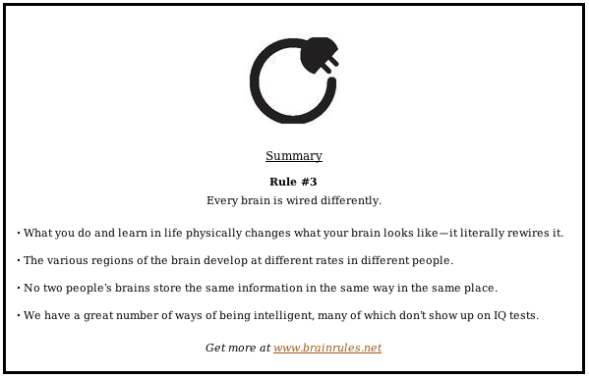H1 – Honor student diversity and development.
There are many different ways to interpret this principal of HOPE, which can be attributed to the diversity and development of the people interpreting it. My initial thought of H1 was that “student diversity” referred to honoring the different cultures, race, religion, etc. that teachers may find in the classroom and their different development, which is definitely one way to interpret it. But after thinking about it further, I decided it makes more sense if the diversity we honor is the diversity in our student’s brains. There is nothing more complex and diverse about humans than the wiring of the human brain.
We learn differently, we interpret differently, everything we do we do differently. This evidence is taken from Medina’s Brain Rule #3 (2008), it sums up the diversity of the human brain and gives perfect reasons as to why it is so important for us to honor student diversity and development.
The speed and the style of learning can vary greatly from student to student and we as teachers must be aware of this. We must be creative in finding different ways to accommodate all of the student’s different learning styles. In a classroom, P.E. in particular, I think one way to accommodate learning rates and styles would be to have advanced students assist other students in their development. This has the potential for increased learning in content, and even further learning in other life skills. This can help students develop communication skills, leadership qualities, and may even help cut down barriers that have segregated students at school and develop new relationships.
My favorite idea from the brain rule is that, “we have a great number of ways to be intelligent.” Everyone is good at something; no one is good at everything, and we, as teachers, need to remind our students of this. It is important for our student’s learning experience in the classroom and life experience outside of it that they see their value in this world and have confidence in themselves. Without such confidence, students can be greatly effected by outside factors such as peer pressure, and their learning and development experience can suffer greatly.
Everyone is good at something is a true statement, but its not always easy to see what that good is. For us to inspire confidence in a student’s value in the world, we first need to know what that value is. If it’s not easy to see what that value is, we can attempt to uncover it by building relationships and earning trust, making students feel comfortable to express themselves and show us their strengths.
